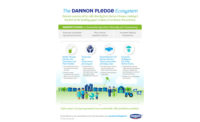Consumers seek new products free from GMOs, additives, gluten and hormones
Mintel’s “Free-from Food Trends U.S. 2015” report reveals that consumers perceive foods with free-from claims to be both healthier and less processed. Consumers appear to be equating “genetic modification,” “artificial” and “unhealthy” as one and the same.
The interest in “real” food appears to be more motivating than the incorporation of healthy ingredients, particularly among Millennials and households with children, according to the report.
While the ice cream/frozen novelty category and the yogurt/yogurt drinks category are buffeted by an expanding array of food and drink options competing for consumer attention for indulgence, health and snackability, there are bright spots of activity that indicate opportunity for boosting growth.
Dollar sales in both of these categories have lacked luster in the recent past. Frozen treats are estimated to tip up 1.6% in 2015 (following no growth in 2014). The slightly stronger estimated 2.9% yogurt and yogurt drinks gains are down from 3.3% in 2014, and represent a steep slowdown from preceding years.
Balancing health, indulgence
The two categories appeal for different reasons. Health plays a strong role in yogurt and yogurt drinks: 66% of U.S. adults surveyed for Mintel’s “Yogurt and Yogurt Drinks U.S. 2015” report identify these products as a source of minerals, 64% say they are a source of vitamins and 63% say they provide protein.
The highest percentage of frozen treat buyers (48%) surveyed for Mintel’s “Ice Cream and Frozen Novelties U.S. 2015” identify the satisfaction of a sweet craving as their reason for purchase and 29% seek a decadent indulgence. While indulgence plays a strong role, health awareness exists: 19% of frozen treat buyers say they are buying less because the products are unhealthy. And though 95% of consumers eat ice cream for dessert (with any frequency), fruit and yogurt are more likely to be turned to with high frequency, suggesting moderation.
Not just for kids
While households with children are more likely than those without to participate in both categories, a shift in focus to adults is seen. This may prove useful as the number of households with children declines and, as the Mintel Trend “Play Ethic” examines, busy adult lifestyles spur interest in the pursuit of playfulness.
Frozen novelties, the second-largest frozen treats segment, struggled in recent years. Dollar sales declines in 2013 and in 2014 have trickled into an estimated 1.5% current-year gain. A limiting factor may be that close to a one-third of U.S. adults (49% among mothers) view these products as being for children.
Contrarily, Unilever’s Magnum brand has found appeal as a mature, upscale ice cream bar. Branding features bold, dark and decidedly un-kidlike colors. Marketing efforts include partnerships with high-end fashion brands and celebrities, and an emphasis on ingredient quality.
Such adult-ification also plays out in flavor and format innovation. Diverse consumer flavor preferences have given way to creative blends, as well as savory, herbal and floral flavors of yogurt and yogurt drinks, according to Mintel Beverage Analyst Elizabeth Sisel.
Drinking it in
Growth in the comparatively small yogurt drinks segment has outpaced that of spoonable yogurt. As spoonable sales are expected to slow in 2015, drinkable yogurt is headed for an estimated 8% gain. Increased snacking and interest in healthy convenience have resulted in strong growth in adjacent beverage categories, including smoothies and nutritional drinks.
Portability also plays a role. Yogurt drinks appear as a strong option for drinking in transit, with 47% of consumers agreeing they are better than spoonable yogurt to consume on-the-go. Similar portability may find its way into ice cream in the form of shakes. Frozen treat makers may consider expanding lines to include drinkable versions, and/or encourage the creation of shakes from their products.
Such innovation appears to be on the right track toward expanding consumption in both categories and picking up the pace in sales growth.
Looking for a reprint of this article?
From high-res PDFs to custom plaques, order your copy today!




